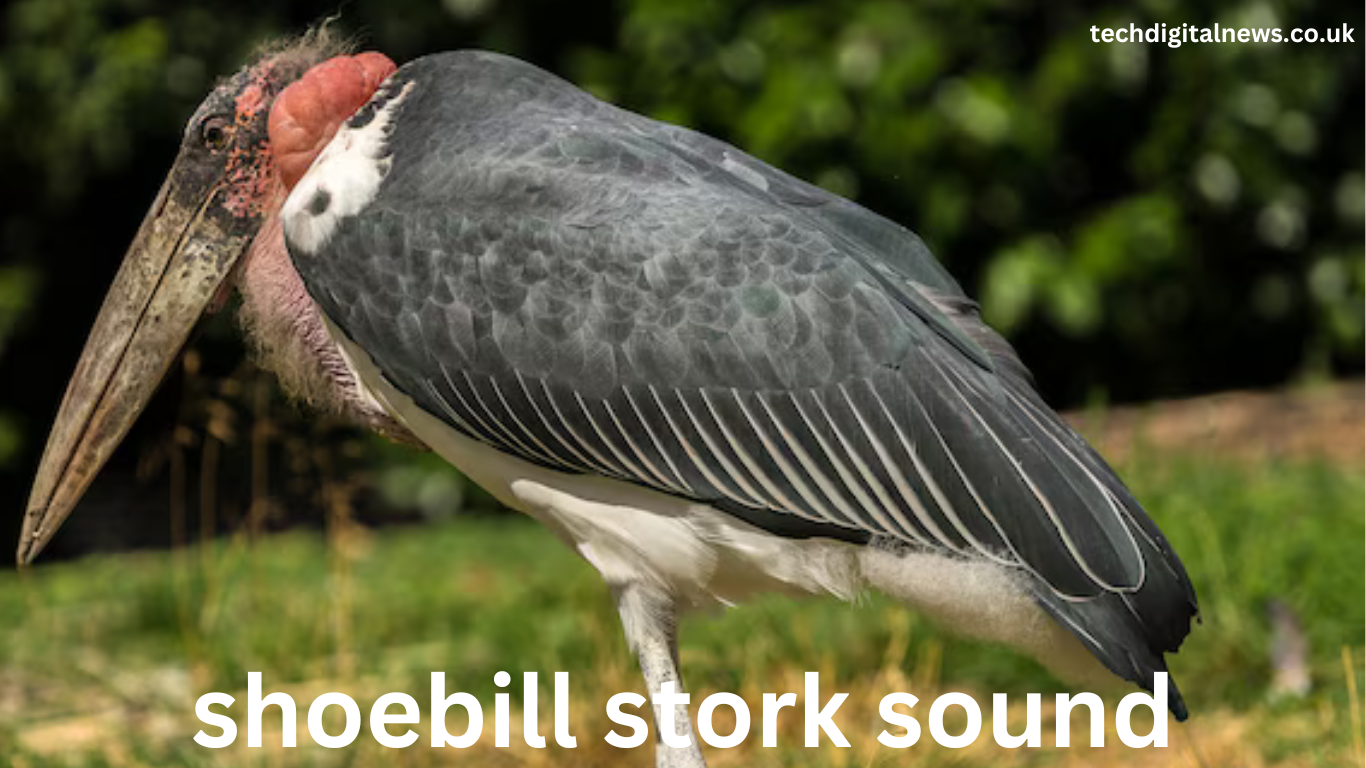Introduction
The Shoebill Stork, with its prehistoric appearance and shoe-shaped bill, is a solitary sentinel of the Central African wetlands. These birds, standing nearly as tall as a human, remain shrouded in mystery, not just because of their appearance but also due to their rare vocalizations. Unlike the melodious songs of many birds, the Shoebill’s sounds are infrequent but impactful, playing a crucial role in their survival strategies and social interactions. This article delves deep into the auditory expressions of this enigmatic bird, exploring their significance both ecologically and behaviorally, and underscores the need for preserving their natural habitats for the intricate roles these sounds play.
What is a Shoebill Stork?
The Shoebill Stork, known scientifically as Balaeniceps rex, is an iconic bird primarily found in the expansive swamps of tropical East Africa. Characterized by its stark, blue-gray plumage and massive bill, the Shoebill can grow up to five feet tall, with a wingspan that is equally impressive. These birds are predominantly silent, but their presence is anything but unnoticed in their native habitats. They thrive in wetland environments where they can stand motionless for hours, hunting their primary prey—fish, snakes, and even small crocodiles. Understanding their physical and behavioral adaptations is key to appreciating the significance of their vocalizations, which are rare and typically reserved for specific interactions.
The Unique Sounds of the Shoebill Stork
Shoebill Storks are not known for a diverse vocal repertoire, but the sounds they produce are fascinating and serve multiple purposes. The most notable sound is a loud, machine-gun-like bill-clattering, which can be heard primarily during the breeding season and serves as a communication tool between mates and a warning to potential intruders. Additionally, they emit a series of moans, whines, and hisses, especially when threatened or during interactions with their chicks. These vocalizations are crucial for maintaining territorial boundaries and reinforcing social bonds within the small family groups.
Understanding the Shoebill’s Vocalizations
Each vocalization of a Shoebill Stork has a specific purpose, ranging from mating calls to alarm signals. During the mating season, vocal communication becomes particularly intense, with pairs engaging in duets of synchronized clattering to strengthen their bonds and coordinate breeding efforts. The alarm calls, though less melodious, serve as an effective deterrent against predators and intruders, ensuring the safety of their young. Researchers have noted that the intensity and frequency of these sounds can vary significantly depending on environmental conditions and the presence of threats, highlighting their adaptability and acute awareness of their surroundings.
The Role of Sound in Shoebill Behavior
The acoustic behaviors of the Shoebill are integral to their survival in the competitive wetland ecosystems. Territorial calls help maintain sufficient hunting grounds for each bird or pair, which is crucial given their reliance on large quantities of fish. The interactions with their offspring, characterized by gentle pecks and soft calls, help in the development of the chicks, which are dependent on their parents for a prolonged period compared to other birds. These sounds are not just functional but are part of the intricate web of behaviors that define the Shoebill’s life cycle.
Recording Shoebill Stork Sounds
Documenting the sounds of Shoebill Storks presents unique challenges, primarily due to their remote habitat and the bird’s reclusive nature. Enthusiasts and researchers often use long-range microphones and recording equipment, strategically placed to capture the rare vocalizations without disturbing the birds. The best times for recording are early morning or late evening during the breeding season when Shoebills are most active vocally. These recordings are invaluable for research, providing insights into the behavior and needs of these elusive birds, aiding in their conservation.
Challenges in Studying Shoebill Stork Sounds
The study of Shoebill vocalizations is complicated by several factors, including their sparse population and inaccessible habitats. Moreover, the sensitivity of these birds to human presence means that researchers must maintain a considerable distance, often limiting the quality and variety of sounds that can be captured. Additionally, the rapid degradation of wetland areas due to human activity and climate change poses a constant threat to the species, making every recording and observation a race against time.
Comparative Analysis with Other Bird Sounds
When compared to other large birds such as herons or pelicans, Shoebill Storks have a relatively limited range of sounds. However, what they lack in variety, they make up for in the significance and utility of their vocalizations. Unlike the more social herons, Shoebills use their sounds primarily for mating and territorial defense, reflecting their solitary nature and the dense, competitive environment in which they live.
Conservation and the Importance of Sound Study
Studying the sounds of the Shoebill Stork is not just about understanding the bird itself but is also critical for conservation efforts. These vocalizations provide researchers with crucial data on population sizes, health, and behavior, which in turn inform conservation strategies and habitat management. Ensuring the survival of the Shoebill also means preserving the delicate balance of their wetland ecosystems, which are crucial for countless other species.
Impact of Climate Change on Shoebill Vocalizations
The impacts of climate change on Shoebill habitats are profound, with changes in water levels and fish populations directly affecting Shoebill breeding and feeding behaviors. These environmental shifts may lead to alterations in their vocal behavior as territories shrink or expand and competition for resources intensifies. Monitoring these changes through sound recordings can help researchers understand and predict the impacts of environmental stressors on Shoebill populations.
Technological Advances in Sound Analysis
Advances in technology have greatly enhanced our ability to study bird sounds. Software for sound analysis allows researchers to dissect and categorize vocalizations in much greater detail than ever before, providing insights into the health and stress levels of birds from their calls. Additionally, remote monitoring technologies enable the continuous observation of Shoebill territories without human interference, reducing stress on the birds and increasing the accuracy of the data collected.
Shoebill Stork Sound in Popular Culture
The Shoebill Stork has become a symbol of wild Africa, capturing the imagination of people around the world. Their striking appearance and unique sounds have featured in numerous documentaries, articles, and social media posts, highlighting the need for conservation and sparking public interest in these majestic birds.
Conclusion
The sound of the Shoebill Stork, while not as varied or melodious as those of other birds, plays a pivotal role in their survival and social structure. Through the study of these sounds, we gain invaluable insights into the life and challenges of the Shoebill, emphasizing the need for ongoing conservation efforts. As we continue to unveil the mysteries of these magnificent birds, their sounds remind us of the complexities of nature and the urgency of preserving such irreplaceable parts of our world’s biodiversity.
FAQs on Shoebill Stork Sounds
- How often do Shoebill Storks vocalize?
- Shoebill Storks are generally quiet but vocalize more frequently during the breeding season to communicate with their mates or signal alarm.
- Can the sound of a Shoebill be heard from a distance?
- Yes, their bill-clattering can be heard from a considerable distance, especially in the quiet of their natural swamp habitats.
- Do Shoebill Storks vocalize year-round?
- Their vocal activity is mostly limited to the breeding season, although occasional calls may be heard year-round.
- Are there differences in vocalizations between male and female Shoebills?
- There are no significant differences noted in the vocalizations between the sexes, as both male and female engage in bill-clattering and other vocal behaviors.
- What does a Shoebill’s call indicate to other birds?
- A Shoebill’s call primarily serves to maintain territory boundaries and communicate with family members, especially in the context of nesting and raising chicks.



